originally posted at https://canmom.tumblr.com/post/666315...
aIt’s almost halloween! Animation Night has survived the year since the last one… but at what cost? hoohoohoohoohooo…
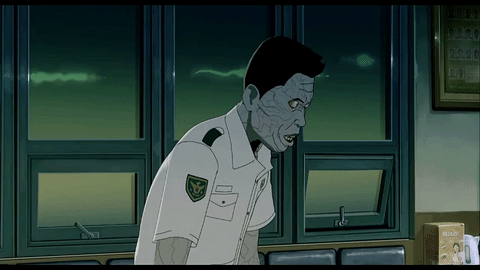
Tonight we once again go to the dark places of the SOCIAL IMAGINARY… the grim corners of the PSYCHE… and watch some really very bad things happen to drawings. Last year’s horror animation night was one of my favourites, so I hope I can maintain that energy this time around… can’t believe we’ve kept this up so long.
So… the last article went into the history of horror as a genre, and its somewhat limited role in animated film, I don’t have a lot to really add this time. What’s change mostly is me! *cackles and turns into a bat*…

…ok sadly I can’t turn into a bat, cat, rat or gnat (not ruling out any other animals), but in this particular corruption arc I’ve definitely accepted that like, I like dark fiction sdfsdf, and I need not fret so much about revealing my evil heart by failing to point out a Problematic depiction and indeed that’s a pretty limited mode of criticism.
As such, we’re gonna return to two films I only dismissed in passing a year ago: Seoul Station, the animated prequel to the Korean zombie film Train to Busan which we watched two days ago, and Shoujo Tsubaki (The Camellia Girl), an ero-guro interpretation of a kamishibai stock character. We’ll also be watching some good old Production I.G. anime in Blood: The Last Vampire, and a fascinating Chilean stop motion film about a Nazi cult called The Wolf House.
So let’s go and put these in context…
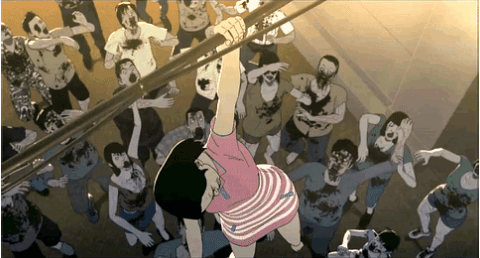
We’ll start with Seoul Station, since that one ties in very straightforwardly. On Tuesday, we watched Train to Busan (2016) by director Yeon Sang-ho. Back then I wrote a little about his career…
Our second film tonight is South Korean zombie film Train to Busan (2016), directed Yeon Sang-ho, who is unusual among Korean directors for mostly working in animation (as we’ll see a little of on Thursday!). Still, his films are in the same idiom as other internationally well known Korean directors like Bong Joon-ho and Park Chan-wook: dark, psychologically realistic films about poverty, trauma and the nastiness that comes from living under decades of military dictatorship, hypercapitalist stratification etc. His first film, The King of Pigs (2011), told the story of a a man reunites with a childhood friend after murdering his wife, and they recall their miserable childhood of class-driven bullying. His second film, The Fake (2013), portrayed a cult leader priest exploiting the people of a town threatened by flooding.
(See also Animation Night 20 for more about Korean animation, both north and south!)
Now of course I have seen Train to Busan; it is pretty much what he said it is, a tense and well executed genre film and a fairly straightforward social parable. Here, let me say a bit about it!
In effect, the film contrasts two bourgeoise: our protagonist Seok-woo, a divorced hedge-fund manager who has been neglecting his daughter Su-an, and a businessman Yon-suk. The film repeatedly returns to the motif of a character running towards a closed door. Early in the film, Seok-woo finds himself locking out masculine working-class husband Sang-hwa under pressures from the others. He has a change of heart after Sang-hwa opens a door for him, and the two fight through a train full of zombies to rescue their families (Sang-hwa’s pregnant wife Seong-Kyeong and a few other characters); however, Yon-suk’s selfishness causes Sang-hwa (and a couple other characters) to die, and he is able to turn the suspicions against Seok-woo’s party. In the film’s finale, both groups flee across a train yard; Yon-suk gets many people killed but is unable to avoid getting zombified, while Seok-woo, though he also gets zombified by Yon-suk, is able to secure an escape for Seong-Kyeong and Su-an.
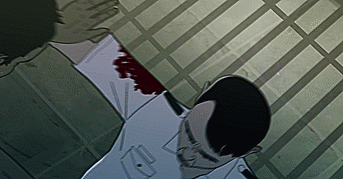
In short, when things get dicey (and there’s zombies), don’t be a ruthless bastard (and capitalists will fuck you). The gender/reproductive futurism angle would be productive to examine (sure seems like the righteous path presented by the film is about about ‘securing a future for children’ on some level lol) but it’s certainly a compelling film. I am not sufficiently familiar (and do not have time to research tonight) to contextualise them in the history of the zombie film, and in case that’s pretty well-covered critical ground. But I enjoyed it sufficiently that, well, I’m looking forward to Seoul Station.
On which subject… produced simultaneously with Train to Busan and released just a month later, this is a prequel revealing exactly how the zombies showed up on the scene. (We know already that the main character of Busan was among the investors in the biotech company responsible for the zombies…) But it is also primarily a character drama, with the zombie apocalypse serving as a background to the abusive relationship between between former sex worker Hye-sun and her boyfriend Ki-woong who wants to push her back into it. They separate just as the zombie apocalypse starts; Hye-sun’s father Suk-gu meets up with Ki-woong and the two try to find Hye-sun in the chaos. Meanwhile the cops arrive, believing the breakout to be an insurrection (metaphor!!! sdfsf) and start barricading the survivors in zombieful territory.
I’m sure it’s going to end very well. Aren’t you?
What I like about these films is that they recognise that the horror in a zombie setting comes primarily not from the zombies themselves, but from humans with power, interpersonal and structural. (No, I haven’t seen the 28days series, although I’ve been meaning to…) Zombies are after all only as scary as a fictional thing; but a state trapping a disposable population in a situation of near certain death? Mm. Yeah. And then you get the quiet possibility of the zombie as becoming something horrifying to the established society, rejecting its values absolutely… at some point we gotta do 2013 BBC drama In the Flesh.
On an animation level, Seoul Station seems to be largely using cel-shaded CGI, frequently shot on 3s to resemble traditional animation. It should be an interesting illustration of the benefits and drawbacks of this technique; the danger is that everything starts to look a bit mechanical when you don’t have the inherent wobbliness and slight off-modelness of humans creating drawings (unless, of course, you are Arc System Works and you go to great efforts to put that into your 3D animations!)
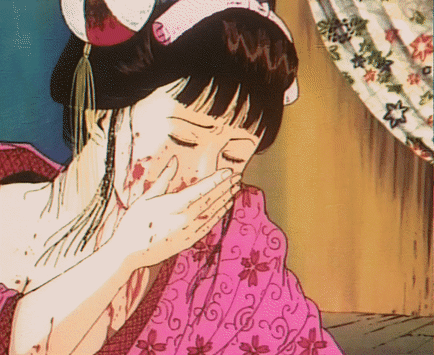
Our second feature is a film that I’ve had my eye on for a while but hoo boy is this one some Content! Shoujo Tsubaki is based on a manga of ero-guro mangaka Suehiro Maho, first published in 1984. We talked a bit about the pre-war ero-guro-nansensu on Animation Night 69; however, the more familiar generation is the post-war ero-guro (wasei-eigo of ‘erotic grotesque’).
Ero-guro, mostly a genre of visual art and manga, refers broadly to pretty much what it sounds like: stories combining eroticism and violence/horror themes of various kinds, typically characterised by a kind of dark, sardonic surrealism. A guro manga might for example be themed around people getting physically screwed onto various surfaces according to their social roles.
Such a theme which became popular in horror and pink films of the 60s and 70s:
Examples include Teruo Ishii’s Shogun’s Joys of Torture (1968) and Horrors of Malformed Men (1969) and Yasuzo Masumura’s Blind Beast (1969), the latter two based on the works of Edogawa Rampo. A more recent example of ero guro in cinema is Sion Sono’s Strange Circus (2005).
At much the same time ero-guro became established in manga and illustration, with some famous pioneering mangaka such as Go Nagai counted among the guro mangakas, and of course good old Toshio Maeda who we discussed in the tentacle section of night 69. I’ve mentioned before but I’m pretty partial to Shintaro Kago’s particular style of surreal gore. Publications of ero-guro manga included the underground manga magazine Garo, most popular in the early 70s, which included ero-guro manga alongside
Shirato’s leftist samurai dramas, abstract art and surrealism, erotic/grotesque, and punk.
as a general eclectic selection of like, interesting adult manga that tended to find an audience among students. And among this magazine’s contributors was Suehiro Maruo, whose work forms the basis of tonight’s film. More on that in a bit!
Since then of course the scope of ‘guro’ has turned mostly into a porn category (among the few filtered by default on most booru sites) primarily referring to dismemberment, and *small cough* I’ve started trying to make my own work after this tradition. (Sadly this month turned into a bit of a mental health disaster so the goretober project is going to have to take a bit longer…)
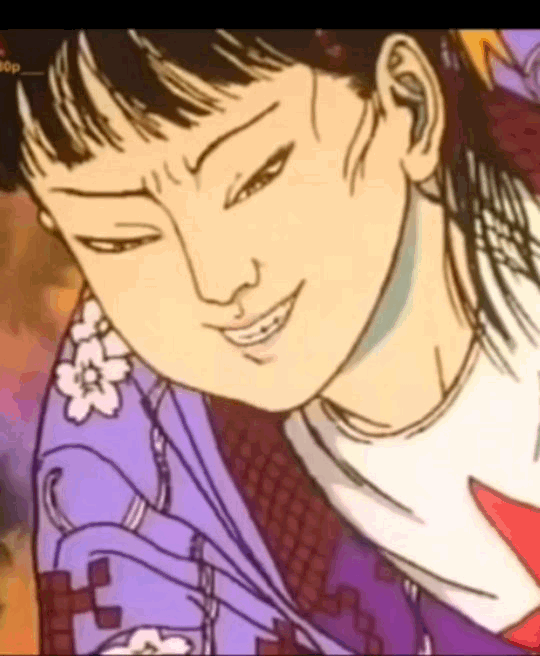
It’s been relatively rare for ero-guro proper to be translated into anime, although there are exceptions, like Rin: Daughters of Mnemosyne which is a fascinatingly odd combination of putting its immortal protagonist into slightly contrived bondage situations, and sort of cross-section through history in which characters grow old and die around the immortals (big thanks for that one @mogsk…) There are a few exceptions: Toshio Maeda’s work would often get OVA treatments in the 80s, and Go Nagai has seen many adaptations, although most of them tend to tone it down!
And then there’s Shoujo Tsubaki (1992), also known as Midori. This is a 45 minute film mostly created by one man Hiroshi Harada over a period of five years on his own funds; much like Belladonna of Sadness it involves a lot of slow pans over illustrations and only occasional bits of limited animation, meaning it actually rather resembles a kamishibai. For a long time - not surprisingly given its extreme content! - this film was limited to underground showings with Harada insisting on a circus freakshow like presentation, but somehow it did manage to get a wider international release.
The film adapts Suehiro Maruo’s manga about an old kamishibai stock character of the flower girl, which draws on the themes of old muzan-e (the gory subset of ukiyo-e) to imagine a broadly sadomasochistic paraphilic world behind the scenes at a circus freakshow. As such it’s, well cw lots of sexual violence with much of it towards children, I’m not kidding, that covers basically the whole film, I will play it last thing tonight and say when it’s over! The film’s protagonist, a young and innocent flower-seller called Hanamura Midori, is kidnapped by a pedophilic circus owner Mr. Arashi, throwing her into contact with a group of more or less sadistic circus performers who variously sexually abuse both her and each other. Eventually she manages to find some degree of companionship when a little person magician named Masamitsu joins the circus, but his designs aren’t necessarily all that good either.
Such a theme may be familiar, going back to films like the (justifiably) controversial 1932 MGM picture Freaks, source of the famous ‘gooble gobble, we accept her’ scene. While Freaks took a paranoid fantasy that the sideshow performers would be conspiring against the rest of society, and the degree to which it’s exploitative or an anti-eugenics film is controversial, Shoujo Tsubaki is more concerned with ‘abnormal’ sexual desires than ‘abnormal’ bodies (although it definitely has some of that as well). I’ll be honest: it probably doesn’t handle it perfectly gracefully (although it takes a very surreal approach that renders it something more allegorical than literal), but it’s one of the very few films that engage at all with a ‘disgusting’ side of society that people would broadly prefer to ignore, and so like, I’m going to just be very upfront about what we’re in for and hope that perhaps some of you would like to see it. I also have a subtitled interview with Harada himself which should be very interesting!
Alongside that, @mogsk prepared me a collection of horror themed short films and music videos, so we’ll put that on in the various interstices.
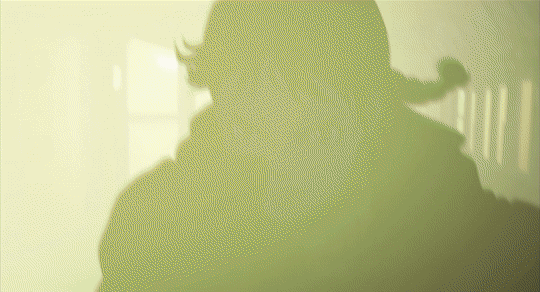
On top of all that, we gotta have a vampire film… and in this case we’ll turn to Production I.G. at the height of their powers, for Blood: The Last Vampire (2000). The premise of this one is pretty straightforward: vampire girl in sailor fuku uses a katana to fight other vampires. The film arose when Production I.G. wanted to make something original, rather than an adaptation:
Production I.G’s president Mitsuhisa Ishikawa wanted to produce a new project that was an original concept rather than being an adaptation of an existing anime or manga series. He approached Mamoru Oshii, who ran a series of lectures known as the “Oshii Jyuku” for teaching new filmmakers how to create their own projects, about his idea and asked him to have his students submit ideas. The submissions of Kenji Kamiyama and Junichi Fujisaki became the basis for the upcoming film: a girl in a sailor suit wielding a samurai sword.[3] Ishikawa suggested Yokota Air Base for the film’s setting, referring to it as the “state of California within Japan”.[3]Hiroyuki Kitakubo was selected as the film’s director, a position he accepted on the condition he be given artistic license with the material.[3]
At Kitakubo’s insistence, the film features designs of Katsuya Terada, whose work was at that point largely in videogames and art books; the main one I know about is the art book Bitch’s Life; and animation direction by long-term Production I.G. animator Kasuchika Kise (who would later go on to create the animation designs for Made in Abyss). It is notable for being one of the first all-digital productions by the studio, setting the stage for GitS:SAC.
I’m not sure it will have the full album cover overload of something like Vampire Hunter D: Bloodlust, but it promises to be a pretty gorgeously animated film, and it is also another 45 minutes one.
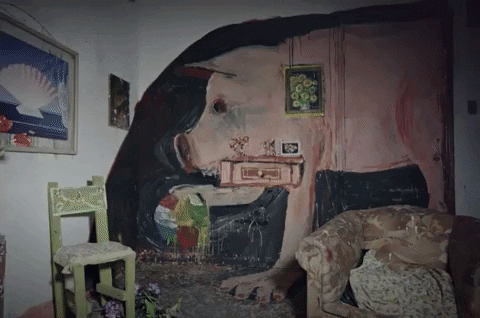
Our last major feature is Chilean stop motion film The Wolf House (La Casa Lobo), which obliquely deals with a real Nazi expatriate cult that tortured people for Pinochet whose members include people like Mengele. Presenting itself as a propaganda fairytale devised by the cult leader inevitably corrupted by his ideology, it tells the story of a girl who runs away, only to find herself in a house run by two pigs that turns into a surreal nightmare.
This one dropped in just 2018 to extremely positive reception, and it’s reviews like this one that give the most detail. The film uses a variety of animation techniques, including paintings on walls and stop motion to show characters distorting and transforming; it looks very unusual and compelling. The creators, Diluvio, have a vimeo account here with various shorts that led up to The Wolf House.
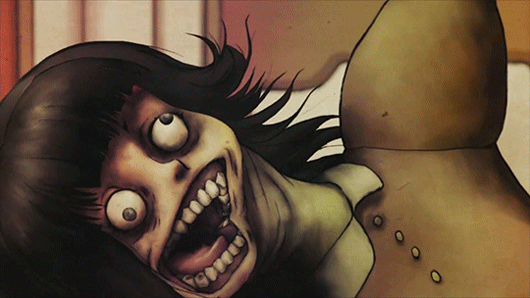
In amongst all that, of course, we’ll be digging into some of the delightful creepypasta energy of Yamishibai for a suitably spooky breather (see last week for explanation :p ). If you have a favourite look up the number and hopefully I’ll be able to show it for you!
Sadly it is not possible for me to show you this year’s most exciting horror animation release, the stop motion Mad God by Phil Tibbett - but hopefully that will get a wider release by this time next year if we’re somehow still going! We also have an anime adaptation of Junji Ito’s legendary horror manga Uzumaki to look forward to sometime next year.
So if you’re ready to head into the dark with me, please turn the lights on or off according to preference, grab some kind of plushie, and join me now in the dungeon of Animation Night 77… at twitch.tv/canmom !
Comments